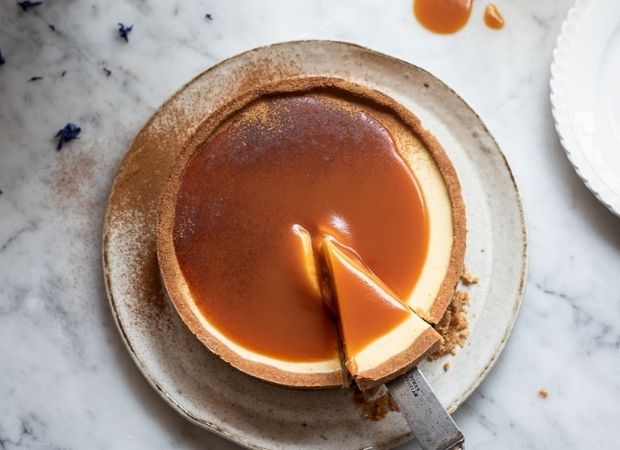It’s rich, smooth and creamy – sultry words, if you ask me, for the perfect baked cheesecake.
Though there are many variations of this delectable dessert – the ones you’re probably most familiar with being a baked vs. no-bake cheesecake – in my opinion, the former is definitely the superior.
Let’s just say, if no-bake cheesecake is Taylor Swift circa 2018, baked cheesecake is Taylor’s Version.
Still, it’s often more daunting to take on than it’s no-bake variant, so I’ve compiled a few tips to getting that rich, smooth and creamy texture. Follow these steps to baking the perfect cheesecake. I promise it won’t only seduce, but have you falling in love!
The base
Though you can venture into making your own pastry shell, most cheesecakes consist of an easy-to-make, no-need-to-pre-bake crust, made from butter and biscuits. You throw it all into a food processor for a fine crumb, and press it into the bottom of a baking paper-lined (pro-tip number one, to ensure you don’t end up serving your final product with the lose bottom of your tin attached) springform tin. My pro-tips for this step:
Though some recipes will encourage you to melt your butter, don’t. Using it right out of the fridge will allow for a thicker, pastier crumb, which is easier to press into and amalgamate in your baking tin.
You want to press it in with the back of a spoon or the bottom of a glass before chilling it in the fridge.
Your filling
Your basic cheesecake filling will likely consist of cream cheese, of course, as well as sugar, eggs (with a few more yolks), vanilla essence and sometimes lemon juice – scroll down for a few of our Food24 recipes.
The trick here is to beat your cream cheese until it’s smooth before adding your other ingredients. Stay away from the low-fat kind – you’re already baking a cheesecake, no need to be too fussed with those calories – and use medium to full-fat cream cheese instead.
Don’t overwhip your mixture. Stop once you see everything is combined and smooth, otherwise your cheesecake will bake much too soft, and you need a bit of firmness for it to set.
Once you’ve poured your filling into your chilled base, it’s onto the baking.
The waterbath method
A water bath, or a bain marie, is a pan of hot water, often used in baking cheesecake.
Here’s what you need to do: Using heavy duty foil, cover the bottom of your baking tin, place it in a large oven tray, then fill the tray with boiling water about halfway.
You can double foil it, just to ensure the water doesn’t seep in.
Though some recipes don’t always include this method, it will ensure your cheesecake bakes evenly and doesn’t crack over the top, while giving you that smooth and creamy texture.
Setting your cheesecake
Most cheesecakes bake for 45 minutes to an hour, depending on the size of the cheesecake and the oven you’re using. You’d need to follow the recipe for this step.
However, you don’t always have to wait for your cheesecake to be perfectly firm after an hour in the oven. Instead, turn the oven off, let it rest a bit in the off oven, and then let it set all the way in the fridge for at least a few hours or overnight. A little wobble in the center can make all the difference between a crumbly texture and creamy one.
The cherry on top
Depending on the cheesecake you’re making, I’d suggest something tart to offset the richness of the cheesecake.
Might I suggest some cherries or berries? Perhaps some chocolate covered strawberries to really seal the deal?
A few cheesecake recipes to try:

